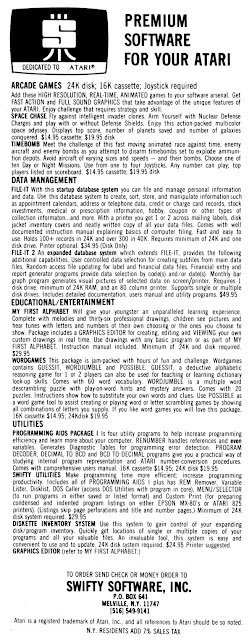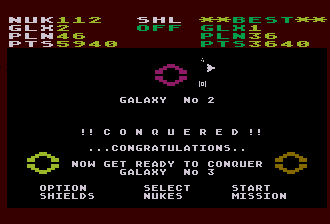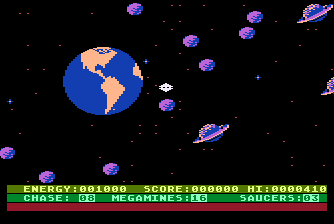I first heard of Boulder Dash in the mid-90's when Java games were all the rage on the Internet, and such a clone had been listed on a web ring. Ever a lover of puzzle games, this maze-digging, boulder-dropping, gem-collecting logic game grabbed my attention with its promise of creator-designed puzzles, and frustrated me with its arcade elements and chaotic yet deterministic falling boulders, but nevertheless, its manic and excessive style entertained me far more than the zen-like purity of the many Sokoban-style games available online had.
Thanks to time spent browsing Mobygames, I can better appreciate that Boulder Dash has its origins in a 1984 8-bit computer game, and thanks to DDG, I have a reason to play the original Atari version.
There are sixteen caves, designated 'A' through 'P', and following my rules permitting a save every half hour of play, I finished them all in seven segments. Sixteen levels might not sound like a lot compared to, say, Lode Runner's 150, but most of them are hard. And for reasons I'll explain later, I don't really feel like every death I suffered was completely my fault, though with practice and sheer muscle memory, I'm sure a single-segment run is doable. The game does seem to be aware of its high difficulty, and includes a level select function, so that you needn't beat fifteen levels in a row just to see the sixteenth. Unlike Lode Runner, a game that also offers one as you'd have to be insane to play it start to finish, you can't start at just any level - only caves 'A', 'E', 'I', and 'M' are selectable, and the rest have to be reached beating the preceding ones in the allotted tries. A good decision, I think, as it keeps the limited lives meaningful.
At first glance, things seems very much like Dig Dug with a character who looks like Waldo if he suffered a teleporter accident involving a carpenter ant. Its dirt-digging and boulder-dropping mechanics with a perspective that can't quite decide whether it's in profile or overhead are very reminiscent. Before long, it becomes clear that Boulder Dash is much more puzzle-oriented, and more resembles the somewhat obscure and enigmatic arcade game The Pit, whose earliest (and lost) incarnation predates all of these games.
Each level is a maze full of gems, boulders, and other interacting widgets, and the slightest dig can set off an avalanche of falling rocks or otherwise kick of a chain reaction that can totally rearrange the level layout, possibly opening paths to inaccessible veins, but may also block crucial passages off permanently, or trap you in a cave-in, or just drop a heavy boulder (or diamond, if the god of irony is bored) on your head. The physics are simple and for the most part deterministic, but it's the interactions between the many stage elements that makes it hard to predict what will happen, and challenging to find a solution.
 |
| Clearing a path to the exit. It will open once I get enough gems. |
There's an interesting comparison to Sokoban here, another tile-based puzzle game of similar vintage, and the differences are more interesting than the similarities. Both involve deterministic mechanics, creator-designed levels, and pushable objects. But Sokoban speaks to a much more minimalist design sensibility, apart from the set of levels with destructible walls (which later versions wisely removed). Sokoban, and Lode Runner too to some extent, are all about maximizing macro complexity with a minimal number of atomic building blocks. It is simple in Sokoban to predict what will happen in a single move - the challenge is predicting which actions won't screw you up several moves later, but the perfect information makes it possible.
Boulder Dash, being as far from a zen-like minimalist design as Ontario is from Japan, has as many gadgets, traps, and baddies as they could fit into the baseline 32KB of memory and often doesn't give you time to consider the full extent of what pushing a single boulder might do. Often, the affected portion of the stage is much larger than what can be shown on the screen. Making a mad dash through a gauntlet of boulders and hoping they dislodge and pile up in a favorable way is frequently a viable tactic, if you have nimble fingers.
Speaking of which, Boulder Dash's biggest flaw is that the controls can be laggy, and this got me killed about as often as my own carelessness did. Sometimes Rockford reacts immediately to your input, and sometimes you need to hold the joystick position for a fraction of a second before he acts. But sometimes he moves two spaces instead of one because, in anticipation of lag, you hold the joystick for a fraction second, and he moves immediately. It is infuriating to plan out a three-step hop and skip where you tunnel under a boulder, dig down, and move out out the way, only for that crucial last step to fail and your run ends with a rock on your head. In spite of this, doing long, serpentine dances through winding tunnels is pretty doable and responsive if you can find the rhythm - it was the short maneuvers of one to three spaces that often failed.
What I think is going on is that approximately every 150ms, the engine polls your joystick and then moves Rockford one space in the direction it is pushed. Sometimes lightly tapping the joystick moves you one space, and sometimes it does nothing at all - if you tap it for less than 150ms, releasing it just before an input tick, then nothing happens. But if you keep it held a bit longer, just to ensure Rockford does move then you risk moving two spaces in the event that an input tick happens immediately and a second one occurs 150ms after that. I believe some form of input buffering would have gone a long way toward improving Rockford's controls.
That said, Boulder Dash's puzzles lend themselves incredibly well to having a variety of solutions, and I'm sure that a skilled and dedicated player could find ones that minimize these risks and execute them reliably enough to complete all sixteen caves in a single session, if not a single life. My approach, in which I'd stubbornly stick with any solution until I made it work, would take a lot more practice and muscle memory to go start to finish like that, but nevertheless, I can't help but feel a bit angry when flawed controls get me killed.
Caves 'A' and 'B' are pretty simple - the first is a wide and linear path of dirt without too many boulders, and the second is grid of small cells, one of which holds a deadly firefly that you needn't disturb. But cave 'C' introduces a huge difficulty spike - not only did I lose my first life here, but I ran out of lives repeatedly, having to restart the game each time until my half hour was up, at which point I made my first save.
So many boulders occupying such narrow passages, and the ticking clock means you can't take your sweet time in clearing up all the maneuvering space you might want! Only 25% of the level is visible at any given moment too, so unless your visual memory is quite excellent, dislodging a set of boulders in one place could very well block off an important passage somewhere below, offscreen. Working your way from bottom to top seems safe, but there's never enough time to be as methodical as one might wish.
Cave 'D' introduces butterflies who patrol the cavern in a predictable right-hand rule pattern. They are deadly to touch but explode and release diamonds when killed. It's an easy level, though it pays to plan your moves so that the sometimes tricky input timing works for you rather than against you. Since they follow the right-hand wall, it's easier to kill them as they ascend a wall on the right than as they descend one on the left. When gathering, don't make the mistake, as I repeatedly did, of forgetting that diamonds can fall and kill you just as easily as boulders - snatch them from the top of the pile, not the bottom.
After every four caves is a bonus round, a chance to earn an extra life. This first one is a simple test of timing.
Cave 'E' reintroduces fireflies, but now you have no choice but to contend with them. Fireflies are left-hand wall followers, and explode when killed, but leave no diamonds when killed. It's not a particularly challenging level as long as you enter each pocket from the right.
Pockets of fireflies and diamonds flank a basin of dirt and boulders in cave 'F'. You've got to free at least four of them, and have a plan to kill or evade them as you snatch the diamonds and run for the exit.
As you enter cave 'G', you'll hear strange bubbling noises. This is the amoeba, which is nonlethal (to you) but will grow uncontrollably, and if it reaches critical mass, explodes into a mass of boulders. Explore as you might, there aren't enough gems to be found here to reach your quota.
The trick, mentioned in the manual, is to trap the amoeba with boulders on all sides except one, leaving a tiny opening where Rockford will be positioned. Once it grows into the entire space, it will suffocate and turn into diamonds, and you'll be poised to enter its husk and collect them.
Cave 'H' features a magic wall that transforms boulders into gems, but it won't reveal itself until you trigger it, and it doesn't last long - you've got to drop ten boulders on it and ensure there's space below for the diamonds before it reverts to a normal wall. It's an easy level when you know where it is, but the first time you're likely to trigger it by accident and then run out of time.
Cave 'I' has massive veins diamonds overhanging two big empty wells and expects you to collect a whopping 75 of them. But you could run out of time waiting for everything to drain. Be efficient and "unplug" both dirt stoppers at once.
'K' is a pretty nasty maze, impossibly dense with boulders. It takes trial and error to find a way through that gets all of the diamonds without trapping yourself.
Cave 'L' is another that you are unlikely to finish on your first attempt. If you're like me, you won't notice the hermetically-sealed rooms to the right of your starting position, and tunnel up and to the right over them. Then, when you reach the other side, and see fireflies trapped in pockets of dirt, you'll realize the real challenge is freeing them, not getting killed by them, and crushing them against the walls of these rooms with boulders. Then, if you're like me, you'll try to do that, open their prisons up willy-nilly and try to smash them with the nearest boulder, and probably fail repeatedly and get frustrated. But if you're smarter, you can make this task much easier by planning ahead.
The amoeba returns in cave 'M', and this time it hangs from the ceiling and can't be buried under rocks like before. But a colony of butterflies, if properly manipulated so that they reach it, will explode and yield showers of diamonds. Don't forget that they too can crush you.
Cave 'N' has a simple problem. Six butterflies, six boulders, each one freeing a firefly when dropped. You only need to kill four of the butterflies to get enough gems, and the fireflies can be dealt with by carefully digging mazes for them to get lost in. It's a very open-ended level that probably has a lot of room for discovering creative solutions.
Cave 'O' is the penultimate stage, and appears to be bereft of gems, until you discover that it has another one of those magic walls that turns boulders into diamonds. Once you know this, the stage isn't all that difficult - just dig plenty of space below the wall, then prime a landslide above the wall without triggering it prematurely, and let it all out - if your landslide is big enough, the magic wall should function for just long enough to transform the 15 required boulders. Just don't accidentally bury the exit under the boulders like I did.
 |
| DAMNIT. |
Finally, there's cave 'P,' appropriately the most difficult cave in the game.
Arghh, it's another magic wall stage! This time, you've got to dig out the fireflies, blow them up to destroy the walls so that you can get inside the two pockets of dirt, clear it out, and then quickly drop rocks onto both of them at once. There are a lot of ways you can screw it up, and once again, if getting the timing right is overly tricky, you'd do well to try to figure out another approach. I, being more stubborn than smart, figured this out eventually, but not before countless frustrating retries.
There's a bonus round afterward that plays a cruel trick with yet more magic wall shenanigans, but at this point I was past caring.
The game then returns you to cave 'A' and increases the difficulty by raising the gameplay speed and lowering your time, and this repeats up to a maximum of level 5, at which point it just loops infinitely. But I'm okay with not doing that.
GAB rating: Good. Despite my misgivings about the controls, and the sheer frustration of suffering the resulting failures, I like this game as much as its Java clones, if not more so. Puzzling out solutions was fun, executing them properly was satisfying, and aside from the spike in cave C, Boulder Dash is paced really well, introducing new concepts every few levels, building on them in subsequent ones, and ending before wearing out its welcome. I have no doubt that the included levels have only begun to explore the puzzle possibilities, which I think is proven by the sheer number of hacked pirate versions offering homemade level sets, not to mention all of its clones, of both commercial and shareware distribution.
First Star would release a level pack sequel in 1985, and in 1986, an official level editor titled Boulder Dash Construction Kit, alongside an obscure third game which featured a sci-fi setting and saw no release outside of Europe. Later releases would include remakes on NES and Game Boy, an arcade version and sequel, releases for XBox Live Arcade, mobile, handhelds, and most recently, a Boulder Dash Deluxe simultaneously released on Steam and Atari 2600, the latter in a very scaled-down but somehow functional form.




















































